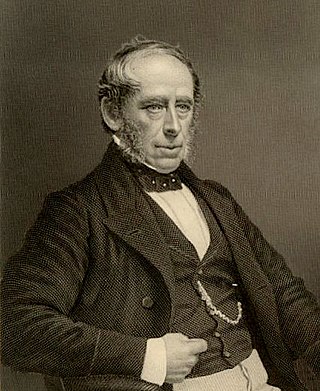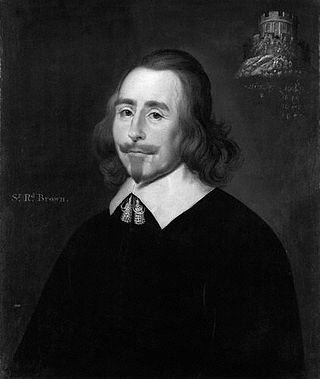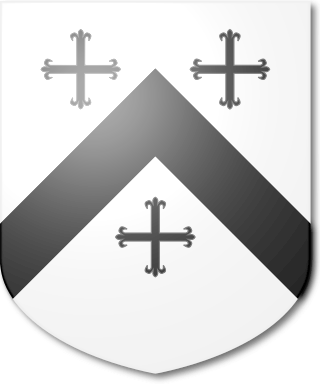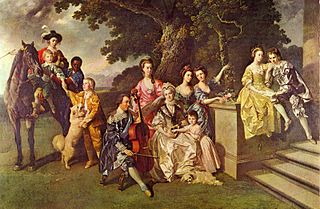Related Research Articles

Viscount Cobham is a title in the Peerage of Great Britain that was created in 1718. Owing to its special remainder, the title has passed through several families. Since 1889, it has been held by members of the Lyttelton family.

Earl of Meath is a title in the Peerage of Ireland. It was created in 1627 and is held by the head of the Brabazon family.

Earl of Kingston is a title in the Peerage of Ireland. It was created in 1768 for Edward King, 1st Viscount Kingston. The Earl holds the subsidiary titles Baron Kingston, of Rockingham in the County of Roscommon, Viscount Kingston, of Kingsborough in the County of Sligo, Baron Erris, of Boyle in the County of Roscommon, and Viscount Lorton, of Boyle in the County of Roscommon, also in the Peerage of Ireland. He is also a baronet in the Baronetage of Ireland. Between 1821 and 1869 the earls also held the title Baron Kingston, of Mitchelstown in the County of Cork, in the Peerage of the United Kingdom.

Earl of Lonsdale is a title that has been created twice in British history, firstly in the Peerage of Great Britain in 1784, and then in the Peerage of the United Kingdom in 1807, both times for members of the Lowther family.

Baron Kilmaine is a title that has been created twice, both times in the Peerage of Ireland. The first creation came in 1722 in favour of the soldier the Hon. James O'Hara. Two years later he succeeded his father as Baron Tyrawley. However, both titles became extinct on the second Baron Tyrawley's death in 1773 without legitimate sons.

Baron Hampton, of Hampton Lovett and of Westwood in the County of Worcester, is a title in the Peerage of the United Kingdom. It was created in 1874 for the Conservative politician Sir John Pakington, 1st Baronet.

There have been three baronetcies created for persons with the surname Booth, one in the Baronetage of England and two in the Baronetage of the United Kingdom. The 1916 creation remains extant, the 1835 creation became extinct in 1896 and the 1611 baronetcy has been dormant since 1797. The senior line of the first creation was elevated to the peerage as Baron Delamer and Earl of Warrington.
Baron Wenlock is a title that has been created three times, once in the Peerage of England and twice in the Peerage of the United Kingdom. The first creation came in 1461 when the soldier Sir John Wenlock was summoned to Parliament as Lord Wenlock. However, he was childless and on his death in 1471 the title became extinct.

There have been two baronetcies created for persons with the surname Buxton, one in the Baronetage of Great Britain and one in the Baronetage of the United Kingdom. One creation is extinct while the other is extant.

There have been ten baronetcies created for persons with the surname Browne, six in the Baronetage of Great Britain, three in the Baronetage of Ireland and one in the Baronetage of Nova Scotia. Only one creation is extant as of 2010. Three of the creations were for members of the Browne family headed by the Viscount Montagu.

There have been six baronetcies created for persons with the surname Smyth, two in the Baronetage of England, one in the Baronetage of Great Britain, one in the Baronetage of Ireland and two in the Baronetage of the United Kingdom. One creation is extant as of 2010.

There have been nine baronetcies created for persons with the surname Anderson, four in the Baronetage of England, one in the Baronetage of Great Britain and four in the Baronetage of the United Kingdom. All creations are extinct.

There have been five baronetcies created for persons with the surname Young, one in the Baronetage of England, one in the Baronetage of Great Britain and three in the Baronetage of the United Kingdom. As of 2014, four of the creations are extant.
There have been three baronetcies created for members of the Gore family, all in the Baronetage of Ireland. All three titles are extant. The family also holds two earldoms and a barony.
There have been five baronetcies created for persons with the surname Vavasour, three in the Baronetage of England and two in the Baronetage of the United Kingdom. As of 2008 four of the creations are extinct while one is extant.
There have been seven baronetcies created for persons with the surname Thompson, one in the Baronetage of England, one in the Baronetage of Great Britain and five in the Baronetage of the United Kingdom. Three of the creations are extinct while four are extant. See also Thomson baronets and Meysey-Thompson baronets.

There have been two baronetcies created for persons with the surname Head, one in the Baronetage of England and one in the Baronetage of the United Kingdom. One creation is extant as of 2007.
There have been five baronetcies created for members of Clan Ramsay, four in the Baronetage of Nova Scotia and one in the Baronetage of the United Kingdom. The baronetcy in the Baronetage of the United Kingdom is extant as of 2023.

Sir Capel Molyneux, 3rd Baronet PC (Ire) was an Irish politician.

Edward Brabazon, 1st Baron Ardee was an Anglo-Irish peer.
References
- George Edward Cokayne, The Complete Baronetage, volume V (Exeter, 1906), page 441
- ↑ "No. 14067". The London Gazette . 25 November 1797. p. 1114.
- ↑ John Burke and John Bernard Burke, A genealogical and heraldic history of the extinct and dormant baronetcies of England, Ireland and Scotland, second edition (London, 1841) page 601
- ↑ Dublin Gazette , 12 October 1852, quoted in "No. 21372". The London Gazette . 26 October 1852. p. 2801.
- ↑ John Burke and John Bernard Burke, A genealogical and heraldic history of the extinct and dormant baronetcies of England, Ireland and Scotland, second edition (London, 1841) page 601
- ↑ "No. 19972". The London Gazette . 23 April 1841. pp. 1056–1057.
- ↑ "No. 20763". The London Gazette . 10 August 1847. p. 2923.